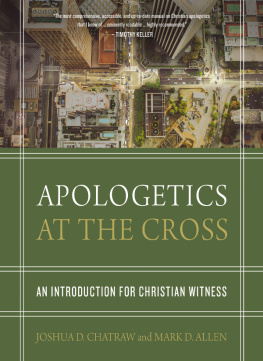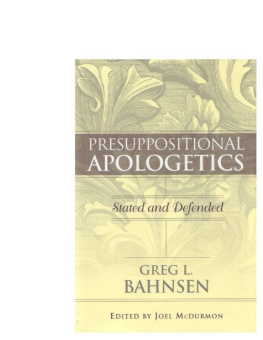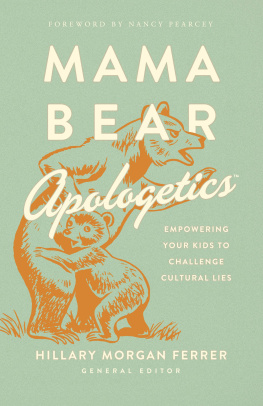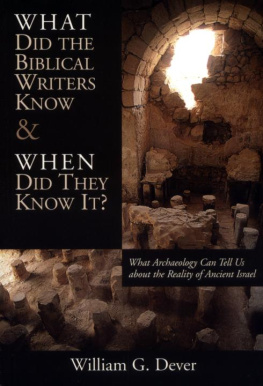Philip Dr. Johnson C. - Biblical Archeology And Apologetics
Here you can read online Philip Dr. Johnson C. - Biblical Archeology And Apologetics full text of the book (entire story) in english for free. Download pdf and epub, get meaning, cover and reviews about this ebook. year: 2013, publisher: Philip Communications, genre: Religion. Description of the work, (preface) as well as reviews are available. Best literature library LitArk.com created for fans of good reading and offers a wide selection of genres:
Romance novel
Science fiction
Adventure
Detective
Science
History
Home and family
Prose
Art
Politics
Computer
Non-fiction
Religion
Business
Children
Humor
Choose a favorite category and find really read worthwhile books. Enjoy immersion in the world of imagination, feel the emotions of the characters or learn something new for yourself, make an fascinating discovery.

- Book:Biblical Archeology And Apologetics
- Author:
- Publisher:Philip Communications
- Genre:
- Year:2013
- Rating:5 / 5
- Favourites:Add to favourites
- Your mark:
- 100
- 1
- 2
- 3
- 4
- 5
Biblical Archeology And Apologetics: summary, description and annotation
We offer to read an annotation, description, summary or preface (depends on what the author of the book "Biblical Archeology And Apologetics" wrote himself). If you haven't found the necessary information about the book — write in the comments, we will try to find it.
Biblical Archeology And Apologetics — read online for free the complete book (whole text) full work
Below is the text of the book, divided by pages. System saving the place of the last page read, allows you to conveniently read the book "Biblical Archeology And Apologetics" online for free, without having to search again every time where you left off. Put a bookmark, and you can go to the page where you finished reading at any time.
Font size:
Interval:
Bookmark:
Biblical Ar cheology, Volume 3
Biblical Archeology And Apologetics
Dr. Johnson C. Philip
Dr. Saneesh Cherian
Editor: JW Thompson

th Revised Edition: 2013
Biblical Archeology And Apologetics
Contents
Archeology is the science of discovering the history, culture, and remains of the older civilizations. Many people shudder at the name of history, partially because of the terrible way in which history is often taught. However, for the initiated and motivated ones, history provides an exciting avenue of knowledge. More so with biblical history and archeology.
Everyone is so familiar with the word "archeology" today that most of them are under the impression that here is a branch of science that has been developing for centuries, if not for millennia. Unfortunately, here is a science that has developed properly only in the last 200 years. Material for its development has been lying around for more than 3000 years, ignored, plundered, or even mindlessly destroyed by mindless people. For example, during the second world-war, soldiers used carvings on the Behistun Inscription for target-practice, destroying portions of it. Ironically this 100150 feet rock-carved inscription, situated 300 feet above ground, is one of the most important and key discoveries in Archeology, secular or biblical.

Closeup of Behistun Inscription
The sheer neglect and destruction [such as for stripping stones from ancient monuments and building new structures] for millennia has been destroying archeological sites for long. Added to it was the lure of hidden treasures. People have been using metal coins, precious metals, precious stones etc for long as the medium to store their assets. Having no banks, many have been burying these. Also, such riches were routinely buried with people in ancient civilizations. Earthquakes and volcanic eruptions often buried entire civilizations, along with their precious metals and gems. Often these were forgotten for centuries, or more, only to be unearthed by some unsuspecting soul would become rich overnight because till recent times all countries had the official policy of "finders are keepers". Thus stories of "hidden treasures" abound in all cultures, and many would look to ancient buildings and structures only with an eye for the possible loot. As a consequence, archeological monuments became a paradise for treasure-hunters, and more so from 1500 AD and after.
Grave-robbing became an established practice, and the riches so discovered soon found themselves melted or sold in the black markets. Neither the finders nor the keepers ever paused to think about their historical value. Consequently, the grave robbers simply threw away [and destroyed] everything the found worthless for their pursuit. This caused further destruction of precious artifacts and writings, specially the writings found on perishable material.
Then in the middle ages quacks began prescribing the ground -up powder of mummies as an important ingredient of medicines, and there was great demand in Europe for mummies from Egypt. This gave further impetus to grave-robbing, establishing an international market for smuggling mummies. On top of that, by 1700, displaying large and beautiful archeological objects in their homes became a status symbol in Europe, further aggravating mindless plundering of buried ancient civilizations.
Perhaps millions of pieces of precious artifacts, writings, and other useful material were destroyed in this way, or were placed in locations so detached from the original that they became practically useless for a scientific investigation of their history. Yet, from this mindless destruction emerged one of the most fascinating sciences, and that is archeology. Today strict laws control all digging, and the finders are no longer keepers. True, grave-robbing goes on even today, but it is at a much smaller level. [Getting caught in the act can often cost one's life]. Archeology has become a more or less mature science. Thousands of museums around the world display ancient objects much more carefully and with proper cataloging than what it used to be in the past. Many countries erect museums close to the location of the find, encouraging both tourists as well as scholars to study the objects more objectively. And the results have been gratifying.
Thus archeology is a 200-year old science, that has come about because of thousands of years of grave-robbing, sorcery, buying objects of status, and medical quackery. The results today of available discoveries are fascinating, inviting more scholars and even amateurs to get involved in digging or studies.
Archeology is the science that studies the past with the help of tangible materials from past civilizations that can be discovered today. Though the systematized form of this science is less than 200 years old, it was long in making through activities that were not exactly meant to develop this branch of science. It would be interesting to examine how it all came to be throughout fits and starts.
Earliest Archeological Activities: According to the records available today, the earliest archeological activity took place between 1550 to 1070 BC when the Pharaohs of Egypt excavated the "Sphinx" that dated to the period of 2575 to 2134 [Old Kingdom]. Sphinx is a massive stylized lion reclining statue, with the Pharaohs face clearly discernible on it. Based upon the the marks left by climate, tools, and humans, and also based upon the ivory carvings [from the older period] discovered in its vicinity, it has become clear that such a reconstruction was done. By the later period [1550 to 1070 BC, New Kingdom], the Sphinx was buried in sand to such a level that only its head and shoulders were visible. The restoration in the New Kingdom brought it back to its earlier glory, and it continues to attract and amaze people even in this third millennium AD.
The information about restoration of Sphinx comes mainly through deductions, and not through written documents. The earliest available written document about archeological excavation is related to Nabonidus, the last ruler of Babylon, who ruled between 555 to 539 BC. He caused the excavation of foundation stones of a building that was dedicated to Naram-Sin, who lived more than 1700 years before his time. However, he did not continue with any substantial excavation, as archeology was not yet a science, or even an object of study.

Pic: Victory stele of Naram-Sin Brought back from Sippar to Susa as war prize in the 12th century BC
People kept on excavating, but not for science but for other reasons. The chief motivation was either to destroy [such as the religion monuments of others] or to plunder, or simple human curiosity. For example, many dug into Pompeii and Herculaneum which were destroyed by overflowing lava. But since their aim was to look for riches, they only destroyed much that would be valuable for a scientific study. Finally Charles of Bourbon [king of Two Sicilies and founder of the House of Bourbon] employed Marcello Venuti to study Herculaneum. This was to be a formal investigation, and from 1738 onwards Venuti employed a large number of people for a systematic excavation. The artifacts and inscriptions thus discovered were studied in some detail. Archeology was not yet an established science, so the study was quite preliminary, but the systematic way in which it was done opened one door to the birth of objective archeology.
Next pageFont size:
Interval:
Bookmark:
Similar books «Biblical Archeology And Apologetics»
Look at similar books to Biblical Archeology And Apologetics. We have selected literature similar in name and meaning in the hope of providing readers with more options to find new, interesting, not yet read works.
Discussion, reviews of the book Biblical Archeology And Apologetics and just readers' own opinions. Leave your comments, write what you think about the work, its meaning or the main characters. Specify what exactly you liked and what you didn't like, and why you think so.







